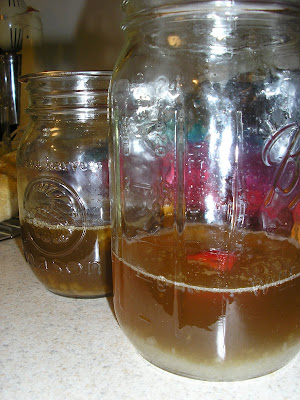29 September 2012
Recipes XI: Fried Spring Rolls
The Deviltry of Seitan: A Meat Alternative
15 September 2012
On Becoming a Ovo/Lacto/Veg'n
Sri Sri Ravi Shankar, Founder of The Art of Living, said, "When you become subtle in your mind and go deeper in your heart, you turn vegetarian naturally.”
I went Veg/Ovo/Lacto/Pescatarian late July 2012. I honestly never had any inclination to ever become a "vegetarian" of sorts. I was pretty much sure I could never give up chicken in place of beans. ugh. Beans. I hate beans. I don't do the bean scene. Sorry daddy, beans are just plain nasty-ola.
09 September 2012
Recipes X: Water Kefir Recipe
Easy Water Kefir Recipe
Probiotics and Friendly Yeasts for Pennies
*Cover with cloth and rubber band on (fruit flies love love love to sneak in unless its covered)

You can drink it right after straining the grains but its kind of tangy and boring. I've made some water kefir juice fizzier than your average cola. The flavor possibilities are endless. Take care of your grains and they will grow. The grains are very forgiving which is good if you're like me and forget them for a week. :( If you have too many, I read you can dry them out and make them into powder. This gives you the ability to add to many dishes or pet food or drinks.

The best part about tibicos/bees/water kefir is it produces about 1 trillion probiotics and friendly yeasts within about a day. I was spending about $45/month on probiotic tablets. You can buy the grains on Amazon or look for blogs who are giving them away for free. These grains really do multiply quickly! Essentially they should never die, if you take decent care of them. This stuff really gets your digestive tract moving. I enjoy drinking about 4 oz first thing in the morning. I've even considered spiking it with rum...erg I know bad idea probably, but it tastes so good.
Bacteria & Yeast species in Water Kefir: http://www.yemoos.com/waterkefirstrains.html
08 September 2012
Plants--the Original Sources of Protein and Amino Acids
By : Dr. John A. McDougall, M.D.
Plants--the Original Sources of Protein and Amino Acids
Proteins are made from chains of 20 different amino acids that connect together in varying sequences—similar to how all the words in a dictionary are made from the same 26 letters. Plants (and microorganisms) can synthesize all of the individual amino acids that are used to build proteins, but animals cannot. There are 8 amino acids that people cannot make and thus, these must be obtained from our diets—they are referred to as “essential.”
After we eat our foods, stomach acids and intestinal enzymes digest the proteins into individual amino acids. These components are then absorbed through the intestinal walls into the bloodstream. After entering the body’s cells, these amino acids are reassembled into proteins. Proteins function as structural materials which build the scaffoldings that maintain cell shapes, enzymes which catalyze biochemical reactions, and hormones which signal messages between cells—to name only a few of their vital roles.
Since plants are made up of structurally sound cells with enzymes and hormones, they are by nature rich sources of proteins. In fact, so rich are plants that they can meet the protein needs of the earth’s largest animals: elephants, hippopotamuses, giraffes, and cows. You would be correct to deduce that the protein needs of relatively small humans can easily be met by plants.
People Require Very Little Protein
The World Health Organization (WHO) recommends that men and women obtain 5% of their calories as protein. This would mean 38 grams of protein for a man burning 3000 calories a day and 29 grams for a woman using 2300 calories a day. This quantity of protein is impossible to avoid when daily calorie needs are met by unrefined starches and vegetables. For example, rice alone would provide 71 grams of highly useable protein and white potatoes would provide 64 grams of protein.
Our greatest time of growth—thus, the time of our greatest need for protein—is during our first 2 years of life—we double in size. At this vigorous developmental stage our ideal food is human milk, which is 5% protein. Compare this need to food choices that should be made as adults—when we are not growing. Rice is 8% protein, corn 11%, oatmeal 15%, and beans 27%. Thus protein deficiency is impossible when calorie needs are met by eating unprocessed starches and vegetables.
The healthy active lives of hundreds of millions of people laboring in Asia, Africa, and Central and South America on diets with less than half the amount of protein eaten by Americans and Europeans prove that the popular understanding of our protein needs is seriously flawed.
03 September 2012
Simple ones: Lusciously Divine Whipped Cream
Easiest recipe ever. You'll never go back to that tub of petroleum rubbish.
1 Pint whole whipping cream


